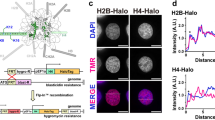Abstract
The constitutive heterochromatin of Dichroplus silveiraguidoi, a species which shows an exceptionally low chromosome number (2n=8), was studied at meiosis with a staining technique on normal and hypotonically treated specimens. The results showed: 1) an unusual behaviour of the heterochromatic blocks located in the so-called synaptic region of the sex bivalent (Neo Y-Neo X), which remains paired from early prophase through metaphase I; 2) in normal or in hypotonically treated cells a heterogeneous configuration of the C-heterochromatic blocks was observed. This configuration is characterized by the existence of small positive granules interconnected by euchromatic filaments and is enhanced by treatment with a low ionic strength solution; 3) A weakly positive stained (intermediate) material was demonstrated in the Neo X chromosome; 4) A large amount of heterochromatin is distributed in the form of granular material along the length of the autosomes and as telomeric and centromeric blocks in all chromosomes. The possible evolutionary mechanisms involved and the significance of the C-band heterochromatin demonstrated in this species are discussed.
Similar content being viewed by others
References
Arrighi, F. E., Hsu, T. C.: Localization of heterochromatin in human chromosomes. Cytogenetics 10, 81–86 (1971)
Bianchi, N. O., Ayres, J.: Heterochromatin location on chromosomes of normal and transformed cells from African green monkey (Cercopithecus aethiops). Exp. Cell Res. 68, 253–258 (1971a)
Bianchi, N. O., Ayres, J.: Polymorphic patterns of heterochromatin distribution in guinea pig chromosomes. Chromosoma (Berl.) 34, 254–260 (1971b)
Bianchi, N. O., Sweet, B. H., Ayres, J.: Heterochromatin in cells derived from Aedes albopictus (Skuse) mosquito tissue culture. Exp. Cell Res. 69, 236–239 (1971c)
Botchan, M., Kram, R., Schmid, C. W., Hearst, J. E.: Isolation and chromosomal localization of highly repeated DNA sequences in Drosophila melanogaster. Proc. nat. Acad. Sci. (Wash.) 68, 1125–1129 (1971)
Brown, S. W.: Heterochromatin. Science, 151, 417–425 (1966)
Chen, T. R., Ruddle, F. H.: Karyotype analysis utilizing differentially stained constitutive heterochromatin of human and murine chromosomes. Chromosoma (Berl.) 34, 51–72 (1971)
Comings, D. E.: Heterochromatin of the Indian muntjac. Replication, condensation, DNA ultracentrifugation, fluorescent and heterochromatin staining. Exp. Cell Res. 67, 441–460 (1971)
Comings, D. E., Avelino, E., Okada, T. A., Wyandt, H. E.: The mechanism of the C- and G-banding chromosomes. Exp. Cell Res. 77, 469–493 (1973)
Comings, D. E., Mattocia, E.: DNA of mammalian and avian heterochromatin. Exp. Cell Res. 71, 113–131 (1972)
Darlington, C. D.: Recent advances in cytology, 2nd ed., p. 551. Philadelphia, Pennsylvania: Blakinston 1937
Diaz, M. O., Saez, F. A.: DNA synthesis in the neo-X neo-Y sex determination system of Dichroplus bergi (Orthoptera: Acrididae). Chromosoma (Berl.) 24, 10–16 (1968)
Drets, M. E., Stoll, M.: Constitutive heterochromatin in Gryllus argentinus. Genetics 71, Suppl. 3, part 2, S15 (1972)
Gagné, R., Laberge, C., Tanguay, R.: Aspect cytologique et localisation intranucléaire de l'hétérochromatine constitutive des chromosomes C9 chez l'homme. Chromosoma (Berl.) 41, 159–166 (1973).
Gallagher, A., Hewitt, G., Gibson, I.: Differential Giemsa staining of heterochromatic B-chromosomes in Myrmeleotettix maculatus (Thunb.) (Orthoptera: Acrididae). Chromosoma (Berl.) 40, 167–172 (1973)
Hansen, K. M.: Heterochromatin (C bands) in bovine chromosomes. Hereditas (Lund.) 73, 63–70 (1973)
Heitz, E.: Das Heterochromatin der Moose. I. Jb. wiss. Bot. 69, 762–818 (1928)
Hsu, T. C.: Heterochromatin pattern in the metaphase chromosomes of Drosophila melanogaster. J. Hered. 62, 285–287 (1971)
Hsu, T. C., Cooper, J. E. K., Mace, M. L., Brinkley, B. R.: Arrangement of centromeres in mouse cells. Chromosoma (Berl.) 34, 73–87 (1971)
Hyde, E. B.: Differentiated chromosomes in Plantago ovata. Amer. J. Bot. 40, 809–815 (1953)
Lee, J. C., Yunis, J. J.: Cytological variations in the constitutive heterochromatin of Microtus agrestis. Chromosoma (Berl.) 35, 117–124 (1971)
Linnert, G.: Die Struktur der Pachytänchromosomen in Euchromatin und Heterochromatin und ihre Auswirkung auf die Chiasmabildung bei Salvia-Arten. Chromosoma (Berl.) 7, 90–128 (1955)
McKenzie, W. H., Lubs, H. A.: An analysis of the technical variables in the production of C bands. Chromosoma (Berl.) 41, 175–182 (1973)
Miller, G., Berlowitz, L., Regelson, W.: Chromatin and histones in mealy bug cell explants: activation and decondensation of facultative heterochromatin by a synthetic Polyanion. Chromosoma (Berl.) 32, 251–261 (1971)
Natarajan, A. T., Gropp, A.: The meiotic behaviour of autosomal heterochromatic segments in hedgehogs. Chromosoma (Berl.) 35, 143–152 (1971)
Nelson. R. D., Yunis, J.: Expression of constitutive heterochromatin in cultured fibroblasts from Microtus agrestis. Exp. Cell Res. 61, 457–461 (1971)
Pallotta, D.: The effect of ions on the structure and function of facultative heterochromatin in the mealy bug. Canad. J. Genet. Cytol. 14, 809–815 (1972)
Pardue, M. L., Gall, J. G.: Chromosomal localization of mouse satellite DNA. Science 168, 1356–1358 (1970)
Polani, P. E.: Centromere localization at meiosis and the position of chiasmata in the male and female mouse. Chromosoma (Berl.) 36, 343–374 (1972)
Saez, F. A.: An extreme karyotype in an orthopteran insect. Amer. Naturalist 41, 259–264 (1957)
Saez, F. A.: The extraordinary karyotype of Dichroplus silveiraguidoi. A possible explanation of its origin. Proc. Int. XII Congr. Genetics, Tokyo, 1, 198 (1968)
Saez, F. A., Pérez-Mosquera, G.: Citogenética del género Dichroplus (Orthoptera: Acrididae). V. Congreso Argentine de Ciencias Biológicas. In: Recientes Adelantos en Biología (R. M. Mejía, J. A. Moguilevky, eds.), p. 111–120. Buenos Aires: Bona, S.C.A. 1971
Schnedl, W.: End to end association of the X and Y chromosome in mouse meiosis. Nature (Lond.) New Biol. 236, 29–30 (1972)
Schneider, E., Heukamp, U., Pera, F.: Loss of heteropycnosis of the constitutive heterochromatin in specifically activated cells of the thyroid gland of Microtus agrestis. Chromosoma (Berl.) 41, 167–173 (1973)
Swanson, C. P.: Cytology and cytogenetics. Englewood Cliffs, N. J.: Prentice-Hall 1957
Takagi, N.: A simple technique to demonstrate the centromeric heterochromatin in the mouse and other animals. Jap. J. Genet. 46, 361–363 (1971)
Author information
Authors and Affiliations
Rights and permissions
About this article
Cite this article
Cardoso, H., Saez, F.A. & Brum-Zorrilla, N. Location, structure and behaviour of C-heterochromatin during meiosis in Dichroplus silveiraguidoi (Acrididae-Orthoptera) . Chromosoma 48, 51–64 (1974). https://doi.org/10.1007/BF00284866
Received:
Issue Date:
DOI: https://doi.org/10.1007/BF00284866




